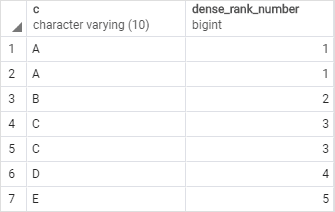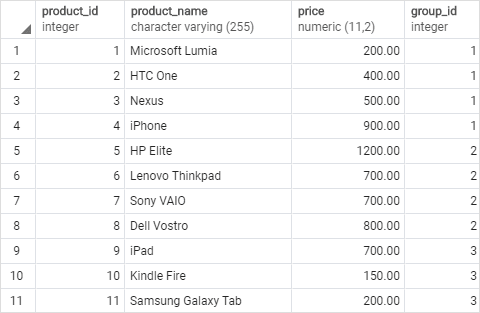PostgreSQL DENSE_RANK Function
Summary: in this tutorial, you are going to learn how to use the PostgreSQL DENSE_RANK() function to assign a rank to each row within a partition of a result set, with no gaps in ranking values.
Introduction to PostgreSQL DENSE_RANK() function
The DENSE_RANK() assigns a rank to every row in each partition of a result set. Different from the RANK() function, the DENSE_RANK() function always returns consecutive rank values.
For each partition, the DENSE_RANK() function returns the same rank for the rows which have the same values
The following shows the syntax of the DENSE_RANK() function:
DENSE_RANK() OVER (
[PARTITION BY partition_expression, ... ]
ORDER BY sort_expression [ASC | DESC], ...
)The DENSE_RANK() function is applied to every row in each partition defined by the PARTITION BY clause, in the sort order specified by ORDER BY clause. It will reset the rank when crossing the partition boundary.
The PARITION BY clause is optional. If you skip it, the DENSE_RANK() function will treat the whole result set as a single partition.
PostgreSQL DENSE_RANK() function demo
First, create a table named dense_ranks that has one column:
CREATE TABLE dense_ranks (
c VARCHAR(10)
);Second, insert some rows into the dense_ranks table:
INSERT INTO dense_ranks(c)
VALUES('A'),('A'),('B'),('C'),('C'),('D'),('E');Third, query data from the dense_ranks table:
SELECT c from dense_ranks; Fourth, use the
Fourth, use the DENSE_RANK() function to assign a rank to each row in the result set:
SELECT
c,
DENSE_RANK() OVER (
ORDER BY c
) dense_rank_number
FROM
dense_ranks;Here is the output:

PostgreSQL DENSE_RANK() function examples
We will use the products table to demonstrate the DENSE_RANK() function.


1) Using PostgreSQL DENSE_RANK() function over a result set example
This statement uses the DENSE_RANK() function to rank products by list prices:
SELECT
product_id,
product_name,
price,
DENSE_RANK () OVER (
ORDER BY price DESC
) price_rank
FROM
products;Here is the output:
 In this example, we skipped the
In this example, we skipped the PARTITION BY clause, therefore, the DENSE_RANK() function treated the whole result set as a single partition.
The DENSE_RANK() function assigned a rank to each product based on the price order from high to low specified by the ORDER BY clause.
2) Using PostgreSQL DENSE_RANK() function over partitions example
The following example assigns a rank to every product in each product group:
SELECT
product_id,
product_name,
group_id,
price,
DENSE_RANK () OVER (
PARTITION BY group_id
ORDER BY price DESC
) price_rank
FROM
products;This picture shows the output:
 In this example, the
In this example, the PARTITION BY clause distributed the products into product groups. The ORDER BY clause sorted products in each group by their prices from high to low to which the DENSE_RANK() function is applied.
3) Using PostgreSQL DENSE_RANK() function with a CTE example
The following statement uses the DENSE_RANK() function with a CTE to return the most expensive product in each product group:
WITH cte AS(
SELECT
product_id,
product_name,
group_id,
price,
DENSE_RANK () OVER (
PARTITION BY group_id
ORDER BY price DESC
) price_rank
FROM
products
)
SELECT
product_id,
product_name,
price
FROM
cte
WHERE
price_rank = 1; In this tutorial, you have learned how to use the PostgreSQL
In this tutorial, you have learned how to use the PostgreSQL DENSE_RANK() function to calculate a rank to each row within a partition of a result set, with no gaps in rank values.